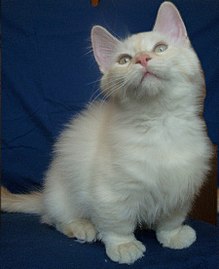Munchkin (cat)
| Munchkin | |
|---|---|

An adolescent munchkin kitten.
|
|
| Origin | United States |
| Breed standards | |
| TICA | standard |
| AACE | standard |
| Domestic cat (Felis catus) | |
The Munchkin is a relatively new breed of cat characterized by its very short legs, which are caused by a naturally occurring genetic mutation. Much controversy erupted over the breed when it was recognized by The International Cat Association in 1995 with critics voicing concern over potential health and mobility issues.
Short-legged cats have been documented a number of times around the world since the 1940s. A British veterinary report in 1944 noted four generations of healthy short-legged cats which were similar to normal cats except for the length of the legs. This line disappeared during the Second World War but other short-legged cats were spotted in Russia during 1956 and the United States in the 1970s.}
In 1983, Sandra Hochenedel, a music teacher in Louisiana, found two pregnant cats who had been chased by a bulldog under a truck. She kept one of the cats and named her Blackberry and half of her kittens were born short-legged. Hochenedel gave a short-legged male kitten from one of Blackberry's litters to a friend, Kay LaFrance, and she named the kitten Toulouse. It is from Blackberry and Toulouse that today's Munchkin breed is descended.
Toulouse was an unneutered cat with outdoor access and after some time a population of stray short-legged cats started to form. Thinking that they might have a new breed, Hochenedel and LaFrance contacted Dr. Solveig Pflueger, a show judge, chairperson of The International Cat Association's (TICA) genetics committee and advisor to the Board of Directors. Together with Dr. David Biller, Head of Radiology at the College of Veterinary Medicine at Kansas State University, Pflueger conducted studies on the cats and determined that the short-legged trait has an autosomal dominant mode of inheritance and that the cats did not appear to have any spinal problems associated with those found in short-legged dog breeds such as the Corgi and Dachshund.
The Munchkin cat was first introduced to the general public in 1991 via a national network televised cat show held by The International Cat Association (TICA) in Madison Square Garden. Critics predicted that the breed would develop back, hip and leg problems similar to those that plague some Dachshunds. Amidst much controversy, the Munchkin was proposed as a new breed by foundation breeders Laurie Bobskill and Robert Bobskill of Massachusetts and accepted by TICA into its New Breed development program in September 1994. One veteran show judge resigned in protest, calling the breed an affront to breeders with ethics. The Munchkin achieved TICA Championship status in May 2003.
...
Wikipedia
